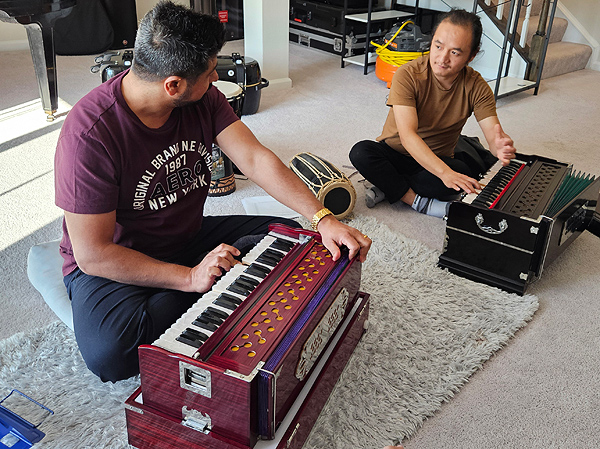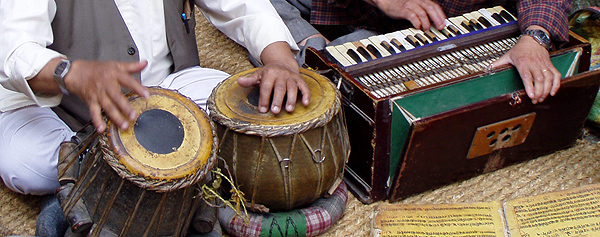April 2024: Nepali Harmonium: Sounds of Home

In our Spotlight series, we take a closer look into the kaleidoscope of traditional arts in Central Pennsylvania and the work of artists featured in our Folk Artists Gallery. In this article, we check in with one of our 2024 traditional arts apprenticeships.
The Pennsylvania Council on the Arts (PCA) offers grants for Apprenticeships in Traditional Arts, to support teachers and students in sharing skills and knowledge. As a PCA Partner, The Susquehanna Folk Arts Center supports local artists in developing their applications. We are pleased that several of those applicants have received Apprenticeship grants!
SFMS Folklorist Amy Skillman conducts site visits to each of those apprenticeships. In March 2024, Amy visited student Bhagirath Khatiwada (bah-ga-REET) and his teacher Muskan Balampaki Magar (moos-KAHN) in Muskan’s home studio to learn about their apprenticeship in Nepali harmonium playing.

Bhagirath Khatiwada (left) and Muskan Balampaki Magar (right)
“If this generation does not preserve this art and culture, there will be a day when people will not find this music here anymore. Once this generation dies, this music will die along with us. So we feel it should be protected and preserved and saved, from us to the next generation.” —Bhagirath Khatiwada
Faraway homelands
Both teacher and student come from small countries in the Himalayas that share borders with Tibet to the north and India to the south, with a bit of India between them (the state of Sikkim). Muskan comes from Nepal: larger, west of Sikkim, and predominantly Hindu. Bhagirath comes from Bhutan: smaller, east of Sikkim, and overwhelmingly Bhuddist. Bhagirath had to leave Bhutan to escape discriminatory practices against citizens who speak Nepali and share the culture of Nepal.
Bhagirath says: “You teach your children your music, your art, your culture... so that your children know who you are, who your parents are, where your family came from, about their way of life.” Himalayan culture is rich and beautiful, with a deep connection to the natural world and a great respect for those who teach. Their music and arts reflect that. Bhagirath extends that sense of connection to sharing his music and arts with others. There must be an even exchange: “If you do not share anything to the bigger community, how do you expect to learn something from the bigger community to enrich yourself?”
A life plump with music
In the Himalayas, music is an integral part of daily life. Every family would have an instrument of some kind in the house, and village folk would gather every evening to play, dance, laugh and sing together. Children grew up hearing and learning the music. Both men speak fondly of that shared tradition of music in their young lives, and the powerful sense of community surrounding it. It’s one of the things they miss most, in their lives here in the United States. Both of them share a commitment to re-creating that culture here — and to building musical connections not only within their own families and their expatriate community but also with the larger community of their new home.
“When we were children, we’d see our elders, including our parents and grandparents, sitting together and engaged in that music. And I realized: that segment, that piece of life is missing. People become so busy [integrating into American culture and becoming economically self-sufficient] that music and arts, the important aspects of life, have been slowly going under shadow. And we feel, that part of life needs to be revived, so that people can live peacefully.” —Bhagirath Khatiwada

Sigismund von Dobschütz’s photo of musicians playing tabla and harmonium in Kathmandu, Nepal, from Wikimedia Commons, licensed under the Creative Commons Share-Alike 3.0 license
Sounds of home

The harmonium is a very common instrument in the Himalayas and the Indian subcontinent, though much less known in the U.S. A cousin of the accordion, with keyboard and bellows, it works and sounds like a portable pump organ.
The harmonium can be used as a melody instrument — Bhagirath is learning to play the melody lines of folk songs — but it is more often used to accompany singers or other melody instruments. As its name suggests (especially when pronounced harmony-um as Bhagirath does), it creates a harmonious drone that supports singers and helps beginners develop vocal skills. It is used to accompany all kinds of music, from classical to popular folk music to Hindustani chants.
The small drums called tabla (tah-BLAH) are another common instrument in the Himalayas. Tabla are a pair of round, asymmetrical hand drums played while seated on the floor. They are played throughout the Indian subcontinent, in classical, popular, folk, and devotional music. Muskan says that just tabla and harmonium together can make a whole concert.
The Teacher: Muskan Balampaki Magar

Muskan Balampaki Magar began learning traditional music from his father in Nepal when he was five years old, and continued throughout his youth. He studied music at Tribhuven University in Kathmandu, Nepal’s leading university, and moved to the United States to accept a scholarship at the renowned Berklee School of Music in Boston. At Bhagirath’s urging and invitation, Muskan left New England and settled with his wife and son in central Pennsylvania. While Muskan loves all forms of music, his heart is committed to preserving the traditional music he learned as a child.
Now in the greater Harrisburg area, Muskan teaches Nepalese music and musical heritage to Nepalis and other interested individuals. He teaches harmonium, tabla, madal (a double-ended hand drum) and other instruments. Most students are taught in their own homes, and their families pay what they can. For Muskan, the important thing is to sustain the music, to make sure younger people learn it, play it, share it, and in time teach it to others.
“This kind of music is not available just anywhere in the world. It is unique to our culture. But this tradition should be shared with other communities as well.” —Muskan Balampaki Magar
The Student: Bhagirath Khatiwada

Bhagirath Khatiwada might be considered a “cultural entrepreneur.” Since coming from Bhutan to the United States 15 years ago, Bhagirath has made it his purpose to ensure the rich culture of his homeland is preserved and promoted.
In Bhutan, Bhagirath’s father played harmonium a little bit, at home. But when the family became refugees, when their house was burned, his father wasn’t allowed to carry out the harmonium. Bhagirath remembers his father grieving the loss of the music and the instrument, and says that’s one of the reasons he wants to learn music himself. This apprenticeship is helping Bhagirath reclaim that part of his father’s life.
“If I am able to introduce this to [my son], later on he will be able to introduce the same heritage to other generations. It needs to be transferred from one generation to another... If we don’t do it, no one can do it.” —Bhagirath Khatiwada
Coming to the harmonium

Bhagirath’s son Biplab (bih-PLAHB) has been learning to play tabla since the age of six. Now 14 years old and quite an accomplished player, he is happy to be carrying on the tradition.
Bhagirath, inspired by his son’s success and his father’s memories, decided to learn to play harmonium himself. He was surprised to find it much more difficult than he had imagined! In fact, he wanted to give up after his first lesson with Muskan, but his family would not let him.
For this apprenticeship, their goal is for Bhagirath to be able to perform at least four songs. He is starting with the basics, still figuring out how to simultaneously play the keys, work the bellows, get the notes and rhythm and timing right, and somehow also sing at the same time. It is a challenge, but a good challenge.
What IS a harmonium?
The hand-pump harmonium is a long wooden box, perhaps 18" square on the ends, and wide enough for a piano-like keyboard with a 3-octave range. It sits on the floor, with the player seated in front of it. The player operates a built-in bellows at the back with one hand, and plays notes on the keyboard with the other hand. The hinged back of the instument drops open by itself, opening the bellows. The player gently pulls it closed to push a steady stream of air across the reeds, making the sound. A pulse of extra pressure on the bellows creates a rhythmic pulse in the music.
The harmonium’s rich organ-like sound and soothing vibration is reminiscent of a meditation mantra. Bhagirath finds it very relaxing, and says playing eases stress, pain, and anxiety.
“Culture, music, art, and language: these are the pieces of yourself — what you are composed of. All these aspects speak about your identity.”

“When people merge into a new community and culture, their cultures, traditions, music, and arts get lost so quickly if they do not get preserved and promoted...
“Now it is on the verge of extinction. If we don’t preserve it in time, it will disappear from our community.” —Bhagirath Khatiwada
Building a school, building connections
Both men dream of creating a school for this music — not simply to teach students, but to create more musicians — to create a larger community of people who love this music and want to share it. And not just within the expatriate community! Some 50,000 Nepali speakers live in Pennsylvania, more than half of them in the greater Harrisburg area. Bhagirath and Muskan believe that building a connection between the Nepali musical community and the American musical community enriches both.
“To start, Muskan has gone to where his students are. But once the energy is created... once the passion for music is created in those young minds... they will come!”—Bhagirath Khatiwada
Building a school will also be a challenge, but a good one. Teachers are scarce: there are few players, and few of those are able to teach. Instruments are hard to come by: the makers are in the Himalayas, not the Americas. And perhaps the biggest hurdle is that, as far as they know, this school would be the first of its kind. But Muskan is clearly making plans. The lower level of his house has become a music room, with Nepali instruments, a grand piano, guitars, and the beginnings of a recording studio tucked into a quiet corner. It's easy to imagine the room filled with players and with music that sounds like home.
Meet them yourself!
Bhagirath and Muskan will be part of our 2024 Apprenticeship Celebration. Come out and hear them play! Keep an eye on our calendar this summer for announcements and details about the event.
In the meantime, here’s Muskan performing one of his own compositions, a contemporary Nepali pop song called "Chhadi Najaau".



Brand icons for Facebook, YouTube, Instagram and other social media platforms are the trademark of their respective owners. No endorsement is implied.